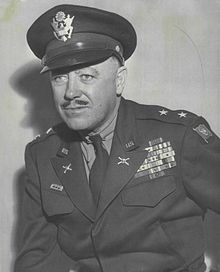William F. Marquat
William Frederic Marquat (born March 17, 1894 in St. Louis , Missouri , † May 29, 1960 in Washington, DC ) was an American officer, most recently major general , and close confidante of Douglas MacArthur , under whom he was in the Pacific War and in served in occupied postwar Japan .
Life
Little is known about marquat's early life. He attended a private high school in Seattle and worked before the First World War as a journalist for the Seattle Times . In 1916 he joined the Coast Artillery Corps as a Second Lieutenant in the National Guard and ended the war as Captain .
He attended the Command and General Staff School at Fort Leavenworth from 1933 and served from 1938 as a major on the staff of the Supreme Commander in the Philippines , Douglas MacArthur. At the outbreak of the Pacific War , he was Colonel and made as MacArthur's chief of air defense the campaign in Bataan with. Due to his joint escape with MacArthur from the Philippines in March 1942 to Australia and his close ties to him for the further duration of the war, he is counted among the Bataan Boys . He served as MacArthur's top anti-aircraft officer and commander of the 14th Anti-Aircraft Command in the battles for New Guinea , the Bismarck Islands and the reconquest of the Philippines . In January 1943 he was promoted to major general.
After the Japanese surrender , he accompanied MacArthur , who was appointed Supreme Commander for the Allied Powers (SCAP), to Japan and temporarily represented the United States in the Allied Council for Japan until he was replaced in this role by George Atcheson in April 1946 . At the end of 1945 he was appointed to succeed Raymond Kramer as head of the Economic and Scientific Section (ESS) of the General Headquarters (GHQ), one of the most influential authorities in the occupying power. He remained in that position until the end of the occupation six and a half years later, longer than any other of the Bataan Boys and longer than MacArthur himself, who was fired by President Truman in 1951 , even though his qualifications for the post were poor and he himself largely relied on his advisors. His name is often mentioned in connection with the mysterious "M-Fund" (English M-fund ), a fund generated primarily from the spoils of former Japanese war, with which anti-communist activities in Japan are said to have been financed, among other things.
After his return to the USA he served from 1952 until his retirement in 1955 as Chief of Civil Affairs and Military Government on the General Staff of the US Army. He died at Walter Reed Military Hospital at the age of 66 and was buried in Arlington National Cemetery.
Awards (selection)
- Distinguished Service Cross (1942)
- Army Distinguished Service Medal (3 ×)
- Silver Star (2 ×)
- Air Medal
literature
- Hiroshi Masuda: MacArthur in Asia: The General and His Staff in the Philippines, Japan, and Korea. Cornell University Press, 2012.
Web links
- William F. Marquat® in the database of Find a Grave (English)
Individual evidence
- ↑ Eiji Takemae: The Allied Occupation of Japan. Continuum, New York 2003, p. 174.
- ↑ Cf. u. a. Norbert A. Schlei: Japan's "M-Fund" Memorandum, January 7, 1991 . In: Japan Policy Research Institute Working Paper No. 11: July 1995.
- ↑ James E. Hewes, Jr .: From Root to McNamara: Army Organization and Administration. Appendix B, p. 401.
| personal data | |
|---|---|
| SURNAME | Marquat, William F. |
| ALTERNATIVE NAMES | Marquat, William Frederic (full name) |
| BRIEF DESCRIPTION | American general |
| DATE OF BIRTH | March 17, 1894 |
| PLACE OF BIRTH | St. Louis , Missouri |
| DATE OF DEATH | May 29, 1960 |
| Place of death | Washington, DC |

